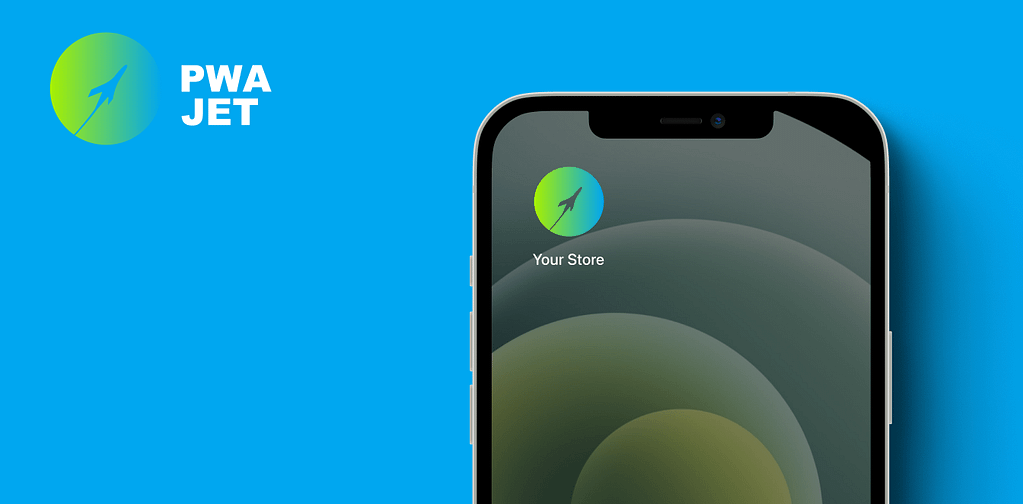In this article, we’ll share some insights about implementing Progressive Web App technology for your eCommerce site. You will get to know why you need to focus on Mobile Commerce, how you can apply the mobile approach, and what are the real benefits connected with each way of creating mobile app ‘feeling’ of your site.
Why is mobile approach important for online brands
With Google’s introduction of the Mobile First index stating that a mobile website is a mandatory listing condition to enter the Google search results, it is obvious that focus on creating awesome mobile user experience becomes the main concern for every online business in the mCommerce market.
Does it mean you should abandon your eCommerce site betting on Mobile Commerce (mCommerce) only. No! But combining both approaches, you can reach better results. And we mean not just search results.
According to Oberlo, in February 2021, 55.56 percent of all web traffic came through mobile phones.
The benefits of mCommerce are evident as most people prefer browsing online stores using their mobiles and tablets before making a buying decision. Mobiles play their role in increasing your brand awareness, gathering extra user data for analytics, complimenting customer experience, and adding additional touch points to communicate with your customers. You have greater opportunities when using the power of both: desktop and mobile versions of your site.
Ways to add ‘mobile’ look and feel
Mobile site
There are different ways when you can add mobile presence to your eCommerce site. One of the most inexpensive ways is simply using a responsive website. This approach can be applied with any theme build for CS-Cart and Multi-Vendor. You will get a retina-tailored skin that will be rendered on a mobile device very naturally without distorting images and stretched content blocks. . With a well-executed mCommerce design, users will experience all the opportunities your desktop version offers, but with a proper mobile display. They can also edit layouts to show them well on mobiles. That’s all. Just a perfectly rendered version of your site. No extra benefits. Generally speaking, building a mobile responsive site does not require much time for implementing a mobile approach. However, users expect a level of quality and functionality that mobile sites sometimes can’t deliver.
Mobile app
Another manifestation of an mCommerce approach, often brought to life by an mCommerce developer, can be a mobile app. In our previous article, we mentioned different methods to create a mobile app. Here we would like to highlight that mobile apps help diversify customer experience and gather another kind of data about users than a desktop application provides. For example, GPS features and camera access can add value in the user’s shopping experience. An app can notify users about the nearest physical store location based on their current position. Or, you can send location-specific promos about sales or a new arrival to the app users.
Mobile apps adopt innovations faster and engage users better. But that is not the last benefit a mobile app brings. Nowadays, more than 2.5 billion social media users use their smartphones for social sharing. Why not use your app to expose your brand to a wider audience? Obviously, you can link your site to a social media account with a mobile site, but mobile apps provide a more coherent social media integration due to its inherent configuration.
Mobile apps have some drawbacks
With all the perks, mCommerce development and mobile applications have disadvantages also – complexity of development and support.
Factors like load times, small images, incomplete information, and poor connection present a problem. Mobile app users have to work way too hard to complete a purchase if these factors are not met. The best eCommerce mobile applications can provide users with extra functionalities, such as checking prices or comparing products offline. But this extra will require additional investment on the app building phase.
Mobile approach is worth considering. The question is in the balance of pains and gains. Mobile sites are less expensive to implement, and apps give you more opportunities to leverage mobile device usage with new technologies and personalized experience. But is there a way to get the benefits of both?
Progressive Web Apps
One more way to introduce mCommerce to your eCommerce site is by leveraging the advantages of mCommerce through Progressive Web Apps (PWAs). If you are already applying mobile-first approach or wish to take your existing online experience to the next level, Progressive Web Apps are an exciting and cost effective new way to engage with your consumers.
A PWA is a web page that looks and behaves like a native mobile app. It combines the features of web browsing with an intuitive app like experience. At this, users don’t need to visit an app store and to download the app.
The term ‘Progressive Web App’ was invented by designer Frances Berriman and Google Chrome engineer Alex Russell in 2015. Google was the first who paved the way for PWAs. Now, PWA are supported by Opera, Firefox and Microsoft Edge also. Apple also demonstrates its PWA commitment introducing service workers (a PWA enabling component) in Safari 11.1 for iOS 11.3. But what is the reason for major brands to turn their eyes towards this just-emerged technology?
Benefits of Progressive Web Apps
- Responsive: Fit desktop, mobile, and tablet form factors.
- Progressive: Work equally well for any mobile device regardless of browser choice as they’re built with progressive enhancement as a core tenet.
- Connection-independent: Service workers allow work without network connection, or with a network of low quality.
- App-like: Look as an app and have app-style navigation and interactions.
- Up-to-date: Service workers update them constantly.
- Safe: Use HTTPS to prevent snooping and ensure an untempered content.
- Discoverable: World Wide Web Consortium (W3C) consider them as applications allowing search engines to find them.
How can PWA gain a competitive advantage in business years ahead
- Progressive Web Application (PWA) is multi-platform as it can be used for different device types. It has the improved speed, and does not need installation or updates.
- It is available for Android and iOS and supported by most big browsers.
- Large brands like Wego, Twitter, Alibaba, Starbucks, Lancôme, and Debenhams use PWA for their mobile stores. If you want to stay ahead of the curve and gain competitive advantage, you should follow mCommerce trends and join the leaders.
- PWA has a higher return on investment:
“Our customers typically see a 20% revenue boost with a PWA, so every minute you don’t have a PWA is a minute spent with 20% less revenue on your busiest customer touchpoint. As an example, a retailer with $20 million in annual ecommerce revenue could lose $1.4 million by waiting a month to offer a PWA, and another $6.8 million by waiting six months”.
Mobify CEO Igor Faletski in the interview for Think with Google
Is PWA right for my business and my customers
A Progressive Web App is relevant for those brand owners who have (or think about developing) a native app, but are not satisfied with their cost of development and support. PWA removes these drawbacks. It helps get more traffic from mobiles, improves site load speed, and all of this with less expenditures than in case of mobile apps. PWA is for digital entrepreneurs who care about return on investment.
For customers, PWA store can offer an opportunity to:
- Have access to a fav brand right from the smartphone’s homescreen;
- Access a store from mobile quickly even with bad/ no Internet connection;
- Save device space with a lightweight application.
What is the difference between PWA and PWAjet
PWAjet is a solution developed by Simtech Development for CS-Cart and Multi-Vendor owners. This solution is more than just a Progressive Web App as it combines PWA and SPA (Single Page Application) technologies. Being PWA, PWAjet uses the Application Shell as its basis, a bare static skeleton of a webpage. The shell loads first all the basic information of your site making PWAjet super lightweight. Being SPA, PWAjet fetches all the content once and then addresses it when needed. As a result, your store gets an increased speed and better usage of resources. Web App Manifest of PWA defines the name, the logo, and the view of the app for a browser. It allows adding PWA to the home screen as a standalone app finding a shorter way to your customers’ hearts.

The advantages of mobile commerce are substantial. With this combination, in supporting browsers, your users can add your eCommerce site to their home screen, launch it in a standalone window and use it again, whether or not they have a network connection. With no Internet, they will continue to browse products adding items to their shopping carts.
What online store owners get if they choose PWAjet
- PWA store fully configured and ready for use for just 3 working days
- Ability to install on the phone’s home screen like a regular mobile application
- High load speed thanks to PWA+SPA technologies available in PWAjet
- UX/UI elements designed with mobile approach in mind
- SEO-friendly site configured with Schema.org and OpenGraph
- Ability to list your PWAjet-powered app on App Store and Play Market
- A safer mobile development with Google-authentication
- Ability to add and configure a range of payment methods of your choice
- Support for default shipping methods configured in CS-Cart
- Launching the application without the Internet connection while maintaining the functionality:
- View products, categories, items, vendors, orders that have already been downloaded to the phone
- Add to cart, wish list
- Writing reviews
- Mobile site with inbuilt analytics system
- Cross-platform: PWAjet runs on any device that supports up-to-date HTML standards
- A range of color scheme and styles customized with the style editor
- Ability to configure any page with the Block Manager.
Cover image source: Freepik

